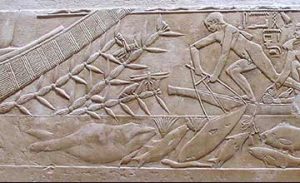
Mastaba of the Two Brothers
The Mastaba of the Two Brothers is located in the section of the Pyramid of Unas, in the Necropolis of Saqqara. The 'Two Brothers' are Niankhkhnum a


The Mastaba of the Two Brothers is located in the section of the Pyramid of Unas, in the Necropolis of Saqqara. The 'Two Brothers' are Niankhkhnum a

The Pyramid of Sekhemkhet is located in the section of Unas Pyramid, in the Necropolis of Saqqara. Though unfinished, the Complex of Sekhemkhet is s

Mereruka held the title "Vizier of the King (Teti) of Upper and Lower Egypt", an office which made him the second most powerful person in the state,

One of the splendid examples of the Sun Temples, built by the rulers of the Fifth Dynasty to express their preference to the Heliopolitan sun-god Re

The site of Abusir includes a group of tombs of high officials from the Old Kingdom, among which is the massive Tomb of Ptah-Shepses who lived at th

From the Temple of Ne-user-Re, we knew that the general complex of a Sun Temple consists of the god's temple, the causeway, and the valley temple. T

Revealed by Alain Zivie, the Tomb of Aper-el (or Aperia) is located in the section of Unas Pyramid, in the Necropolis of Saqqara. Aper-el was a vizi

The Double Mastaba of Ptahhotep and Akhhotep is located in the western section of the Necropolis of Saqqara, in the way to the Serapeum. Dating ba

The Mastaba of Ankhmahor is situated in the section of the Pyramid of Unas, in the Necropolis of Saqqara. Ankhmahor held the titles of a Vizier, 'Fi

Mehu was ‘Chief Justice and Vizier’ during the early part of Dynasty VI, probably during the reigns of Teti and Pepy I, and was married

Pharaoh Shepseskaf was the last ruler of the Fourth Dynasty and reigned for perhaps 5 years. The Mastaba of Shepseskaf (also known as 'Mastabet Phar

Queens Nebet (Nebit) and Khenut were wifes of King Unas (Unis). The Double Mastaba of Nebet and Khenut is located in the section of the Pyra

The Pyramid of King Djedkare is located in the southern section of the Necropolis of Saqqara. The owner of the pyramid was the 8th ruler of the Fift

The Pyramid of Merenre I is located in the southern section of the Necropolis of Saqqara. It dates back to King Mer-En-Ra (Merenre) of the Sixth Dyn

The Pyramid of Pepy I is located in the southern section of the Necropolis of Saqqara. It is famous for the Pyramid Texts written on its walls. It i

The Pyramid of Pepy II is located in the southern section of the Necropolis of Saqqara. King Pepi II ruled the country for about 94 years, longer th

The Pyramid of Queen Iput, wife of King Teti (2323-2291), was constructed at a distance of about 100 m to the north of the mortuary temple of her hu

The Pyramid of Khuit, which belongs to Teti's wife, Khuit, is located in the section of Teti Pyramid in the Necropolis of Saqqara, near the Pyramid

The Pyramid of Neith is located in the southern section of the Necropolis of Saqqara, near the pyramid of her husband, Pepi II. The pyramid had a co

The Pyramid of Userkaf is located in the middle section of the Necropolis of Saqqara, near Zoser Complex. Dating back to Fifth Dynasty, it belongs t

The Pyramid of Userkaf is located in the middle section of the Necropolis of Saqqara, near Zoser Complex. Dating back to Fifth Dynasty, it belongs t

The Pyramid of Teti is located in the section of the Pyramid of Teti in the Necropolis of Saqqara. Its original height was about 52.5 m. It was poor

The Step Pyramid Complex was built by King Zoser (Djoser) of the Third Dynasty and designed by his architect Imhotep. The only entrance of the compl

The Ibis and Baboon Serapeum is located in the northern section of the Necropolis of Saqqara. They are underground galleries reserved for burying th

Dating back to the Roman Period, the Pantheon of the Philosophers is a semi-circle of statues of famous Greek philosophers and poets, locate

Dating back to the Greco-Roman Period, the Serapeum is located in the western section of the Necropolis of Saqqara. Close to the Serapeum lies the G

Horemheb was the "General of Generals of the Army" during the reigns of Tutankhamun and Ay. He ordered the works of his tomb before he occupied the

Hesire was a high official during the reign of Netjerikhet (Dosjer) of the Third Dynasty. He held the titles of: 'The Great one of Buto', 'Chief Den

The Tomb of Kaaper (or Ka-Aper) is situated in the northern section of the Necropolis of Saqqara. Dating back to the Fifth Dynasty, duri

Dug entirely out of the rocky wall, the Tomb of Irukaptah is located in the section of Unas Pyramid, in the Necropolis of Saqqara. The tomb is known

Nefer held the titles ‘Supervisor of Artisans’ and ‘Director of Choir Singers’ during early Fifth Dynasty. His tomb was a no

Maya was Overseer of the Treasury and Overseer of Works during the reign of the boy-king Tutankhamun in the Eighteenth Dynasty. At Tutankhamun's dea

Neferherenptah was a barber in the royal palace with the title ' Overseer of Hairdressers of the Great House'. He was the father of a judge and scri

The Tomb of Neferrenpet (Neferren-pet) is located in the section of Unas Pyramid, in the Necropolis of Saqqara. It dates back to the reign of Ramses

The Tomb of Idut (Idu) is located in the section of the Pyramid of Unas, in the Necropolis of Saqqara. It is one of the highly important tombs at th

Ti was an overseer of the pyramids and Sun-Temples of Kings Neferirkare and Neuserre of the Fifth Dynasty. His Tomb is located in the western sectio